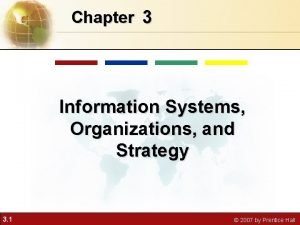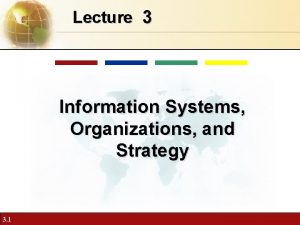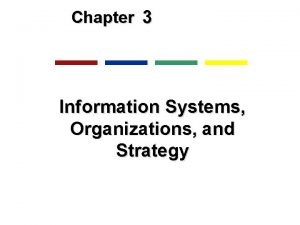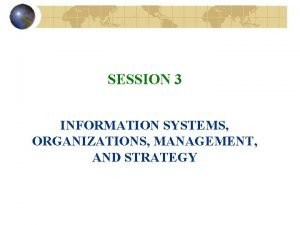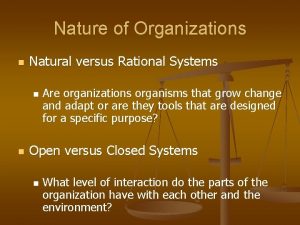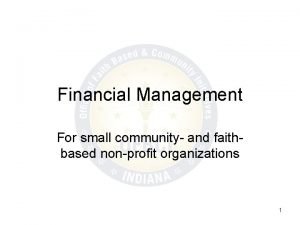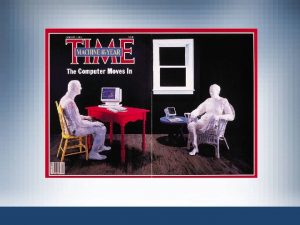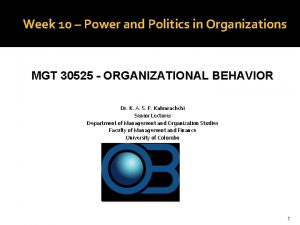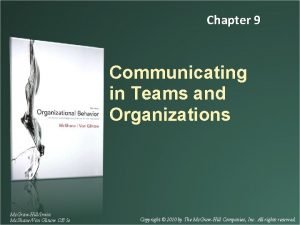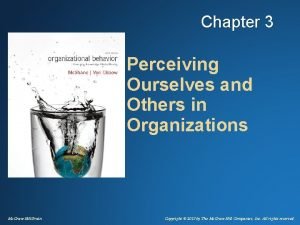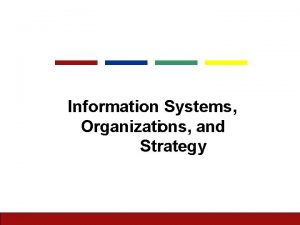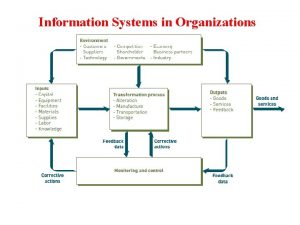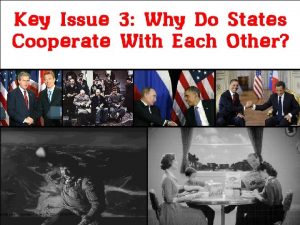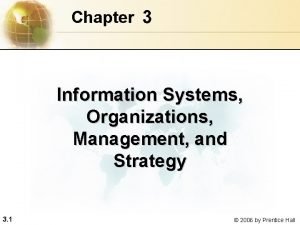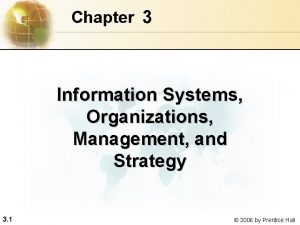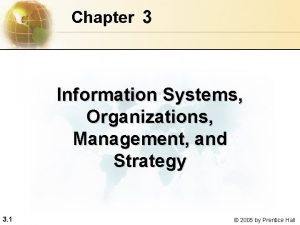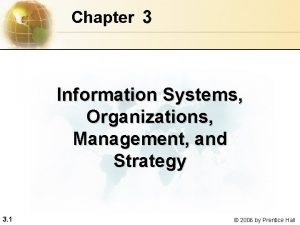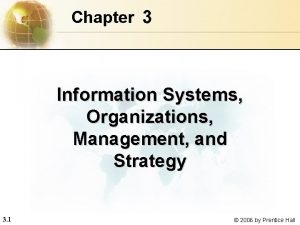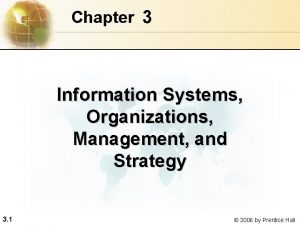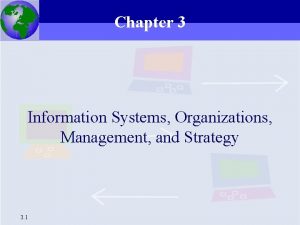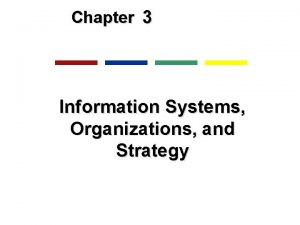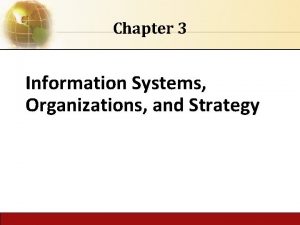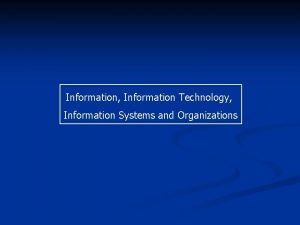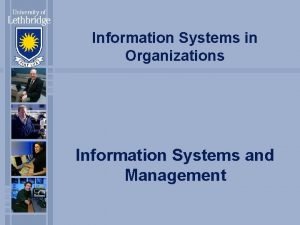Information Systems Organizations and Strategy Management Information Systems





















- Slides: 21

Information Systems, Organizations, and Strategy Management Information Systems: Managing the Digital Firm, 12 e Authors: Kenneth C. Laudon and Jane P. Laudon Copyright © 2013 Dorling Kindersley (India) Pvt. Ltd. Chapter 3

Information technology and organizations influence one another Complex relationship influenced by organization’s § Structure § Business processes § Politics § Culture § Environment, and § Management decisions Management Information Systems: Managing the Digital Firm, 12 e Authors: Kenneth C. Laudon and Jane P. Laudon Copyright © 2013 Dorling Kindersley (India) Pvt. Ltd. Organizations and Information Systems

Organizations and Information Systems Copyright © 2013 Dorling Kindersley (India) Pvt. Ltd. The Two-way Relationship Between Organizations and Information Technology This complex two-way relationship is mediated by many factors, not the least of which are the decisions made—or not made—by managers. Other factors mediating the relationship include the organizational culture, structure, politics, business processes, and environment. Figure 3 -1 Management Information Systems: Managing the Digital Firm, 12 e Authors: Kenneth C. Laudon and Jane P. Laudon

What is an organization? Technical definition: § § § Stable, formal social structure that takes resources from environment and processes them to produce outputs A formal legal entity with internal rules and procedures, as well as a social structure Behavioral definition: A collection of rights, privileges, obligations, and responsibilities that is delicately balanced over a period of time through conflict and conflict resolution Management Information Systems: Managing the Digital Firm, 12 e Authors: Kenneth C. Laudon and Jane P. Laudon Copyright © 2013 Dorling Kindersley (India) Pvt. Ltd. Organizations and Information Systems

Features of organizations Use of hierarchical structure Accountability, authority in system of impartial decision making Adherence to principle of efficiency Routines and business processes Organizational politics, culture, environments and structures Management Information Systems: Managing the Digital Firm, 12 e Authors: Kenneth C. Laudon and Jane P. Laudon Copyright © 2013 Dorling Kindersley (India) Pvt. Ltd. Organizations and Information Systems

Routines and business processes Routines (standard operating procedures) § Precise rules, procedures, and practices developed to cope with virtually all expected situations Business processes: Collections of routines Business firm: Collection of business processes Management Information Systems: Managing the Digital Firm, 12 e Authors: Kenneth C. Laudon and Jane P. Laudon Copyright © 2013 Dorling Kindersley (India) Pvt. Ltd. Organizations and Information Systems

Organizational politics Divergent viewpoints lead to political struggle, competition, and conflict Political resistance greatly hampers organizational change Management Information Systems: Managing the Digital Firm, 12 e Authors: Kenneth C. Laudon and Jane P. Laudon Copyright © 2013 Dorling Kindersley (India) Pvt. Ltd. Organizations and Information Systems

Organizational culture: Encompasses set of assumptions that define goal and product § § § What products the organization should produce How and where it should be produced For whom the products should be produced May be powerful unifying force as well as restraint on change Management Information Systems: Managing the Digital Firm, 12 e Authors: Kenneth C. Laudon and Jane P. Laudon Copyright © 2013 Dorling Kindersley (India) Pvt. Ltd. Organizations and Information Systems

Organizational environments: Organizations and environments have a reciprocal relationship Organizations are open to, and dependent on, the social and physical environment Organizations can influence their environments Environments generally change faster than organizations Information systems can be an instrument of environmental scanning, act as a lens Management Information Systems: Managing the Digital Firm, 12 e Authors: Kenneth C. Laudon and Jane P. Laudon Copyright © 2013 Dorling Kindersley (India) Pvt. Ltd. Organizations and Information Systems

Disruptive technologies Technology that brings about sweeping change to businesses, industries, markets Examples: personal computers, word processing software, the Internet, the Page. Rank algorithm First movers and fast followers § First movers – inventors of disruptive technologies § Fast followers – firms with the size and resources to capitalize on that technology Management Information Systems: Managing the Digital Firm, 12 e Authors: Kenneth C. Laudon and Jane P. Laudon Copyright © 2013 Dorling Kindersley (India) Pvt. Ltd. Organizations and Information Systems

Economic impacts IT changes relative costs of capital and the costs of information Information systems technology is a factor of production, like capital and labor IT affects the cost and quality of information and changes economics of information § § Information technology helps firms contract in size because it can reduce transaction costs (the cost of participating in markets) Outsourcing Management Information Systems: Managing the Digital Firm, 12 e Authors: Kenneth C. Laudon and Jane P. Laudon Copyright © 2013 Dorling Kindersley (India) Pvt. Ltd. How Information Systems Impact Organizations and Business Firms

Transaction cost theory Firms seek to economize on transaction costs (the costs of participating in markets) § Vertical integration, hiring more employees, buying suppliers and distributors IT lowers market transaction costs for a firm, making it worthwhile for firms to transact with other firms rather than grow the number of employees Management Information Systems: Managing the Digital Firm, 12 e Authors: Kenneth C. Laudon and Jane P. Laudon Copyright © 2013 Dorling Kindersley (India) Pvt. Ltd. How Information Systems Impact Organizations and Business Firms

How Information Systems Impact Organizations and Business Firm is nexus of contracts among self-interested parties requiring supervision Firms experience agency costs (the cost of managing and supervising) which rise as firm grows IT can reduce agency costs, making it possible for firms to grow without adding to the costs of supervising, and without adding employees Management Information Systems: Managing the Digital Firm, 12 e Authors: Kenneth C. Laudon and Jane P. Laudon Copyright © 2013 Dorling Kindersley (India) Pvt. Ltd. Agency theory:

Organizational and behavioral impacts IT flattens organizations § Decision making pushed to lower levels § Fewer managers needed (IT enables faster decision making and increases span of control) Post-industrial organizations § Organizations flatten because in postindustrial societies, authority increasingly relies on knowledge and competence rather than formal positions Management Information Systems: Managing the Digital Firm, 12 e Authors: Kenneth C. Laudon and Jane P. Laudon Copyright © 2013 Dorling Kindersley (India) Pvt. Ltd. How Information Systems Impact Organizations and Business Firms

Copyright © 2013 Dorling Kindersley (India) Pvt. Ltd. How Information Systems Impact Organizations and Business Firms Flattening Organizations Information systems can reduce the number of levels in an organization by providing managers with information to supervise larger numbers of workers and by giving lower-level employees more decision-making authority. Figure 3 -8 Management Information Systems: Managing the Digital Firm, 12 e Authors: Kenneth C. Laudon and Jane P. Laudon

Organizational resistance to change Information systems become bound up in organizational politics because they influence access to a key resource – information Information systems potentially change an organization’s structure, culture, politics, and work Most common reason for failure of large projects is due to organizational and political resistance to change Management Information Systems: Managing the Digital Firm, 12 e Authors: Kenneth C. Laudon and Jane P. Laudon Copyright © 2013 Dorling Kindersley (India) Pvt. Ltd. How Information Systems Impact Organizations and Business Firms

Overcoming Resistance to Change: Lewin’s Change Process 1 Unfreezing 2 Moving 3 Refreezing Management Information Systems: Managing the Digital Firm, 12 e 8– 17 Authors: Kenneth C. Laudon and Jane P. Laudon Copyright © 2013 Dorling Kindersley (India) Pvt. Ltd. Managing Organizational Change

How to Lead the Change Unfreezing Phase � Establish a sense of urgency (need for change). � Mobilize commitment to solving problems. Moving Phase � Create a guiding coalition. � Develop and communicate a shared vision. � Help employees to make the change. � Consolidate gains and produce more change. Refreezing Phase � Reinforce new ways of doing things. � Monitor and assess progress. Management Information Systems: Managing the Digital Firm, 12 e 8– 18 Authors: Kenneth C. Laudon and Jane P. Laudon Copyright © 2013 Dorling Kindersley (India) Pvt. Ltd.

The Internet and organizations The Internet increases the accessibility, storage, and distribution of information and knowledge for organizations The Internet can greatly lower transaction and agency costs § Example: Large firm delivers internal manuals to employees via a corporate Web site, saving millions of dollars in distribution costs Management Information Systems: Managing the Digital Firm, 12 e Authors: Kenneth C. Laudon and Jane P. Laudon Copyright © 2013 Dorling Kindersley (India) Pvt. Ltd. How Information Systems Impact Organizations and Business Firms

How Information Systems Impact Organizations and Business Firms Environment Structure § Hierarchy, specialization, routines, business processes Culture and politics Type of organization and style of leadership Main interest groups affected by system; attitudes of end users Tasks, decisions, and business processes the system will assist Management Information Systems: Managing the Digital Firm, 12 e Authors: Kenneth C. Laudon and Jane P. Laudon Copyright © 2013 Dorling Kindersley (India) Pvt. Ltd. Central organizational factors to consider when planning a new system:

Information systems can improve overall performance of business units by promoting synergies and core competencies Synergies § When output of some units used as inputs to others, or organizations pool markets and expertise § Example: merger of Bank of NY and JPMorgan Chase § Purchase of You. Tube by Google Management Information Systems: Managing the Digital Firm, 12 e Authors: Kenneth C. Laudon and Jane P. Laudon Copyright © 2013 Dorling Kindersley (India) Pvt. Ltd. Using Information Systems to Achieve Competitive Advantage
 Information systems organizations and strategy
Information systems organizations and strategy Information systems, organizations, and strategy
Information systems, organizations, and strategy Information systems, organizations, and strategy
Information systems, organizations, and strategy Information systems organizations and strategy
Information systems organizations and strategy Chapter 3 information systems organizations and strategy
Chapter 3 information systems organizations and strategy Chapter 1 introduction to management and organizations
Chapter 1 introduction to management and organizations Natural vs rational systems
Natural vs rational systems Faith based financial accounting software
Faith based financial accounting software Management in criminal justice organizations
Management in criminal justice organizations Business strategy triangle
Business strategy triangle Strategic triangle model
Strategic triangle model Knowledge management and specialized information systems
Knowledge management and specialized information systems Corporate strategy and business strategy
Corporate strategy and business strategy Aggregate planning
Aggregate planning Power and politics in organizations
Power and politics in organizations Voluntary health and welfare organization examples
Voluntary health and welfare organization examples Floral shops bookstores and farms are examples of
Floral shops bookstores and farms are examples of Formal groups fulfill both and functions in organizations.
Formal groups fulfill both and functions in organizations. Persuasive communication
Persuasive communication Power politics and conflict in organizations
Power politics and conflict in organizations Perceiving ourselves and others in organizations
Perceiving ourselves and others in organizations Csusm clubs and organizations
Csusm clubs and organizations
